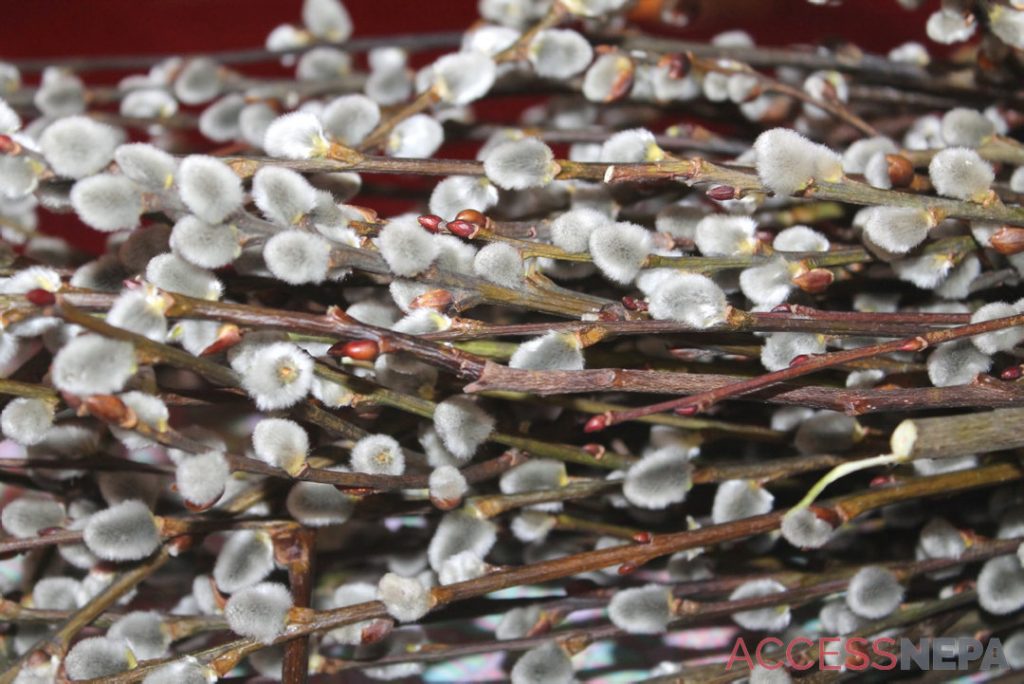BY LEAH ZERBE
The other day I returned home from an appointment to find a wonderful surprise at my doorstep: A bundle of pussy willow cuttings wrapped in moist newspaper.
Giddy, I brought the branches full of velvety catkins inside, added some fresh water to a few vases and placed the cuttings on the kitchen counter.
To me, this late-winter “bouquet” was far more beautiful than any vase full of fancy roses. And that’s because of the incredible benefits these cuttings will provide.
Meet Salix discolor
While there are several species referred to as pussy willow, the one that best supports nature here in Pennsylvania — and the only one I recommend planting — is the species Salix discolor.
Avoid pussy willow species like Salix caprea and Salix cinerea — they are native to other parts of the world like Europe and Asia and, while ornamental, don’t help butterflies, bees and wildlife like our native Salix discolor.
Salix discolor’s male and female catkins develop on separate plants. This species grows wild in sunny wetlands and could be the perfect plant for moist, bright spots in your yard where other plants fail. One quick note: Because of that, be sure to avoid growing them near septic areas because their deep taproots could cause a headache in these spots.
Other than that, this multi-stemmed, large shrub/small tree is perfect in rain gardens with consistent moisture and sun and will help suck up rainwater to reduce runoff and flooding.
Pollinator lifeline
The “fur” of the catkins helps capture the warmth of the sun, helping the catkin blooms emerge in late winter/early spring. This serves as an essential early source of pollen for our emerging (and very hungry!) native bees and more.
The bright yellow blooms are often buzzing with activity on warm late-winter and early spring days, attracting honey bees, mason bees, flies, wasps and many other pollinators desperate for nutrition.
I can’t help but think what it’s like for a hungry pollinator to land on a Salix discolor flower. It must be the ultimate sense of relief. And it’s a lifeline all of us should be planting, if the conditions of our space are right.
Butterfly factories
According to Doug Tallamy, a professor in the Department of Entomology and Wildlife Ecology at the University of Delaware in Newark, the Salix discolor native to our area is second only to oak in terms of its ability to support moth and butterfly species.
Salix discolor hosts 455 species of caterpillars, serving as a larval plant for viceroy, mourning cloak, red-spotted purple butterflies and so many more. (Mourning cloaks actually overwinter in the plant’s bark and crevices, emerging in the spring.)
If we want the beautiful diversity of these winged beauties in our gardens and neighborhoods, we must plant species like Salix discolor and other host plants native to our region. Species that originated in other parts of the world simply aren’t set up to support our local food web. They might look pretty, but are largely ecological duds when planted in Pennsylvania because butterfly and moth caterpillars simply can’t nibble on their leaves and reproduce.
Free bird food & more
All of that early-spring insect activity also attracts hungry birds like goldfinches and chickadees. But beyond that, the fact that Salix discolor hosts so many caterpillars means it’s also a crucial food source for parent birds looking for caterpillars to feed their baby birds later in the season.
For now, I’ll keep my generously gifted cuttings in fresh water on the countertop. And when the frost-free date for our area comes around in May, I’ll stick the branches in the ground in a moist farm meadow and look forward to the pollinators and birds they will nourish next spring.
Contact the writer: leah.zerbe@gmail.com




